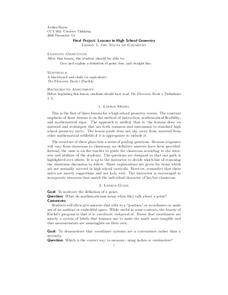Curated OER
Story Bears
First graders study different teddy bears featured in stories. For this lesson on popular story characters, 1st graders are provided information on the authors who wrote famous stories with bears as the main character. Students create a...
Curated OER
If you have to find the area of a region, how would you calculate it?
Fifth graders find the area of rice farms. In this area lesson, 5th graders draw shapes and grid them to find the area. They compare different rice fields to see which one takes up more space and has the larger area.
Curated OER
Rice Farming History
Second graders map the progress of rice farming by using a map of the United States. In this rice farming lesson plan, 2nd graders draw a line on the map from where rice farming started to the progression of its growth.
Curated OER
Rice Around the World
Third graders draw pictures to show the life of early colonists and how they set the standard for rice farming. For this rice farming lesson plan, 3rd graders read about how and when Americans set the standards for growing and producing...
Curated OER
The History of Rice
Fourth graders investigate the history of rice by drawing a timeline of important dates. In this food history lesson, 4th graders research the history of rice, where it came from, and who first used it for food. Students create a...
Curated OER
Plate Tectonics
Young scholars examine plate tectonics and landforms. In this plate tectonics lesson students complete an activity. Young scholars practice drawing maps that show different fault lines and the land formations that were caused.
Curated OER
Conjectures and Conclusions
Students draw conclusions and make conjectures given a specific scenario. In this geometry lesson, students model real life scenarios using properties of triangles. They model number facts and explain why the outcome is what it is.
Curated OER
Symmetrical Journals
Students identify symmetrical shapes around their classroom and make symmetry journals. In this symmetry lesson plan, students make drawings of symmetrical shapes inside their journals.
Curated OER
Who Were the Dissidents?
Students discover how Japanese dissidents spoke out against the injustice practiced in Imperial Japan. In this Japanese history lesson, students listen to a lecture about the silent dissidents in the nation prior to World War II and the...
Curated OER
The Hello Goodbye Window: Visual Art
Young scholars create a portrait of themselves with a grandparent. In this visual art activity, students read the book entitled The Hello Goodbye Window and discuss the events. Young scholars then draw a portrait of themselves and...
Curated OER
Feeling Alone
Second graders listen to the story, The Whispering Cloth and discuss the message of the story. In this feeling alone lesson, 2nd graders make connections about what feeling alone means to them. Students define and interpret experiences...
Curated OER
Carving Mountains
Students explore geography by participating in an illustration activity. In this land-form activity, students define vocabulary terms associated with glaciers and forests. Students utilize pens, cardboard and pottery clay to draw and...
Curated OER
Reintroduce /D/
Students study letters. In this letter identification lesson, students practice recognizing and pronouncing the letter "d." They work as a group to actively participate in various drills the teacher leads them through. This lesson...
Harvard University
The Nouns of Geometry
Socratic questioning to teach Euclidean geometry? "The Nouns of Geometry," followed by "The Verbs of Geometry," and the misfit, "A Beginner's Story - The Equilateral Triangle" are designed to encourage learners to explore various topics...
Teach Engineering
Thrown for a Loop
Round and round it goes. Class members observe a current carrying loop in a magnetic field and calculate its associated torque. They then apply what they have learned to example problems to solve for the torque and to calculate the...
Teach Engineering
Magnetic Fields
Introduce your class to magnetic fields with an activity that demonstrates that a compass is affected by the magnetic field of the earth, unless a closer, stronger magnetic field is present. Pupils can use this fact in the associated...
Virginia Department of Education
Rotation
Rotate this resource into your lesson plans. Scholars rotate polygons in the coordinate plane by multiples of 90 degrees. They then compare the original and new figures to develop conjectures about coordinate points after rotations.
Teach Engineering
Levers that Lift
Introduce your class to to the remaining three simple machines-- the lever, pulley, and the wheel-and-axle with a plan that includes the three different types of levers in the discussion of levers. The activity continues with the...
Teach Engineering
Rube Goldberg and the Meaning of Machines
A Rube Goldberg machine does not really look like it would make work easier. Introduce your class to Rube Goldberg with a resource that shows how his inventions make simple tasks harder to complete.
Curated OER
Responding to Alcohol: What's Important?
Students examine the effects on motor functions in mice. They make observations and graph their data. They analyze the data and draw conclusions in each of the three experiments.
Curated OER
Uh??? I Don't Know
Young scholars explore the short /u/ sound. They practice making the sound and use letterboxes to spell 'u' words. They recite tongue twisters and read with a partner, 'Fuzz and the Buzz.' They practice writing 'u' words and draw a...
Curated OER
Picture It!
Students participate in visualization exercises as a reading comprehension strategy. As the teacher reads a poem, the students visualize the setting, then read the poem "Daddy's Making Dinner" and create a drawing of what they visualize...
Curated OER
Tadpoles to Frogs!
Third graders observe the tadpoles/frogs and draw a picture in their journals every week to monitor its growth with 100% accuracy. They observe tadpoles/frogs and record at least two changes or the observations the tadpole undergoes...
Redefining Progress
Have and Have-Not
Is there a correlation between a country's wealth and the extent of its ecological footprint? What exactly constitutes an ecological footprint, and how does one country stack up against the rest? This is a unique instructional activity...

























